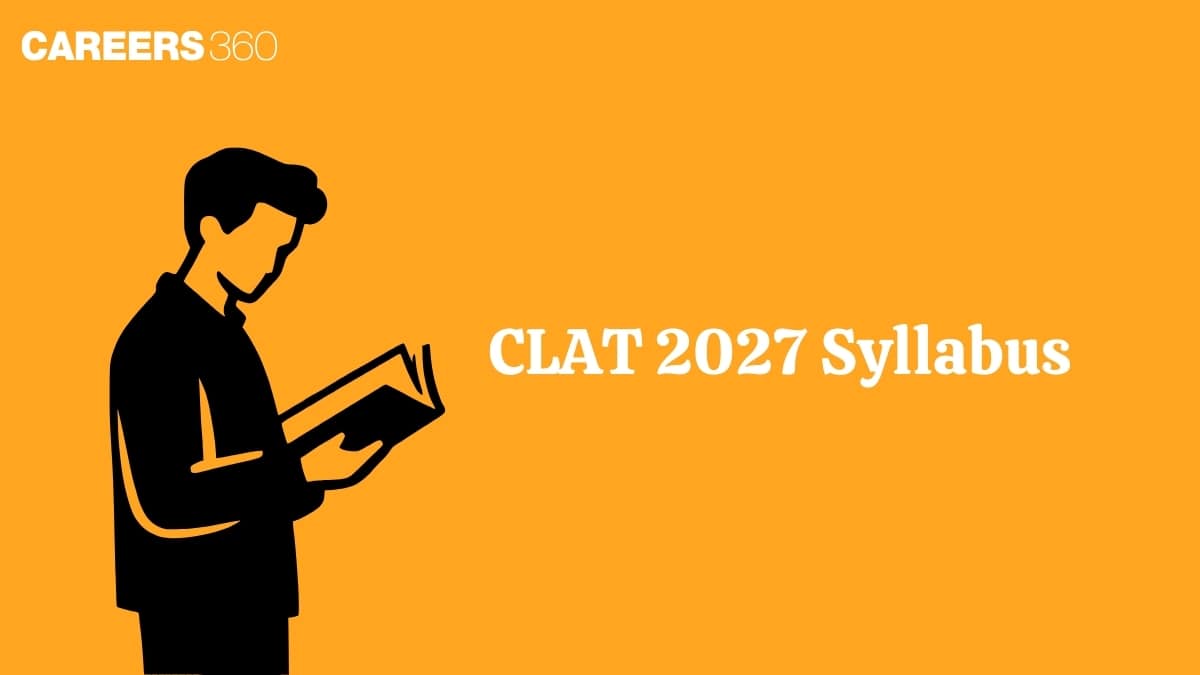Amity University-Noida Law Admissions 2026
Among top 100 Universities Globally in the Times Higher Education (THE) Interdisciplinary Science Rankings 2026
The Common Law Admission Test (CLAT) is a prestigious national-level entrance exam conducted annually for admissions into undergraduate (UG) and postgraduate (PG) law programs. It is the primary entrance exam for National Law Universities (NLUs) and other private and government colleges that accept CLAT scores for their law programs. The CLAT 2027 syllabus is divided into two streams: UG and PG. Each stream is designed to assess skills relevant to their respective academic levels. Understanding the CLAT exam syllabus 2027 thoroughly is crucial for candidates aiming to secure a seat in top law schools.
This Story also Contains

The syllabus of CLAT 2027 covers a comprehensive range of subjects split across five main areas for UG. The PG syllabus, on the other hand, focuses on advanced legal subjects. Knowing the subject-wise weightage, exam pattern, and preparation tips helps aspirants plan their study effectively and perform well in the CLAT exam.
Particulars | CLAT 2027 UG | CLAT 2027 PG |
Exam name | Common Law Admission Test (CLAT) - UG | Common Law Admission Test (CLAT) - PG |
Duration | 2 hours (120 minutes) | |
Exam time | 2 pm to 4 pm | |
Exam mode | Offline (pen and paper-based) | |
Total questions | 120 MCQs | |
Total marks | 120 | |
Difficulty level | Class 12 standard (quantitative up to class 10 level) | LLB/graduate level |
Subjects covered | 2. Current Affairs & GK | Passages based on core law subjects, like Constitutional Law (highest weightage), Jurisprudence, Contract, Criminal Law, etc. |
Marking scheme | +1 for correct answer; -0.25 for wrong; 0 for unattempted | |
Language | English | |
Subject | Questions (approx.) | Weightage | Important topics |
English Language | 22–26 | ~20% | Reading comprehension, synonyms, antonyms, analogies, fill in the blanks, idioms, grammar, and sentence improvement |
Current Affairs & GK | 28–32 | ~25% | Recent national & international events, government policies, awards & honours, sports, science & technology, static GK, history |
Legal Reasoning | 28–32 | ~25% | Legal principles, facts-based questions, legal knowledge, logical deduction from legal propositions, and case studies |
Logical Reasoning | 22–26 | ~20% | Arguments, conclusions, assumptions, puzzles, syllogisms, blood relations, coding-decoding, sequences |
Quantitative Techniques | 10–14 | ~10% | Basic arithmetic, percentages, ratios, averages, profit & loss, discounts, bar graphs, data interpretation, algebra, geometry |
Total | 120 | 100% |
The CLAT PG syllabus tests advanced legal knowledge necessary for LLM admissions. It is based on objective questions derived from legal texts and judgments. The syllabus covers these subjects:
Constitutional Law
Jurisprudence
Law of Contracts
Criminal Law (IPC, CrPC)
Administrative Law
Law of Torts
Contract Law
Property Law
Public International Law
Tax law
Company Law
Intellectual Property Rights (IPR)
Among top 100 Universities Globally in the Times Higher Education (THE) Interdisciplinary Science Rankings 2026
Ranked #18 amongst Institutions in India by NIRF | Ranked #1 in India for Academic Reputation by QS Rankings | 16 LPA Highest CTC
Subject | Books/sources |
Legal Reasoning |
|
GK |
|
Logical Reasoning |
|
English |
|
Quantitative |
|
Current Affairs | Newspapers like The Hindu and The Indian Express, or legal journals, articles, editorials, and explanations |
Build a strong reading habit: Regularly read newspapers like The Hindu or The Indian Express to improve current affairs knowledge and to stay updated with daily news.
Master legal reasoning: Focus on understanding legal principles and practising case-based questions.
Practice quantitative techniques: Start with the basics, practice subjects like data interpretation, and progressively solve complex problems using previous year papers.
Enhance logical reasoning: Solve puzzles, syllogisms, and analogies regularly to sharpen critical thinking skills.
Use standard reference books: Refer to the CLAT recommended books specialising in each section for better coverage.
On Question asked by student community
Hello
With an AIR of 9076 and EWS rank of 846 in CLAT 2026, getting a top NLUs is unlikely, which is why you didn’t get a seat in the first round. However, you still have some chances in lower-tier NLUs like NLU Odisha, NLU Assam, NLU Tripura, NLU Meghalaya,
Hello
With a CLAT 2026 score of 60.75, AIR 17,715, and OBC-NCL rank 3,347 as an out-of-Delhi candidate, getting a seat in the Faculty of Law, Delhi University is very unlikely. DU’s cut-offs for OBC candidates are usually much higher, even in later rounds. You should keep backup options like
Hello,
With AIR 10542 and OBC rank 1843, getting top NLUs is unlikely. However, you still have chances in newer or lower ranked NLUs like NLU Assam, NUSRL Ranchi, MNLU Nagpur/Mumbai, especially in later or vacancy rounds. Also consider good private law colleges as backup options.
Since you scored 8000 AIR in CLAT, getting into top NLUs may not be possible, so it is a good idea to look for affordable and good law colleges.
State government law colleges are usually low in fees, and have decent reputation. Some options include Government Law College, Mumbai, Faculty
Yes you can get addmission into UPES dehradun with the clat rank of 8037
Through the below college predictor you will get the list of best collges based on your rank:
CLAT College Predictor 2026 (Free) - https://law.careers360.com/clat-college-predictor
Hope it helps
Among top 100 Universities Globally in the Times Higher Education (THE) Interdisciplinary Science Rankings 2026
Excellent curriculum; an impressive range of electives, besides core law courses. Up to 100% merit scholarship on a first-come, first-served basis
Ranked #18 amongst Institutions in India by NIRF | Ranked #1 in India for Academic Reputation by QS Rankings | 16 LPA Highest CTC
AICTE & UGC Approved | NAAC A+ Accredited
NAAC A+ Accredited | Among top 2% Universities Globally (QS World University Rankings 2026)
NAAC A++ Approved | Curriculum Aligned with BCI & UGC